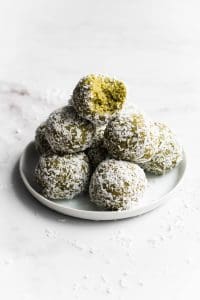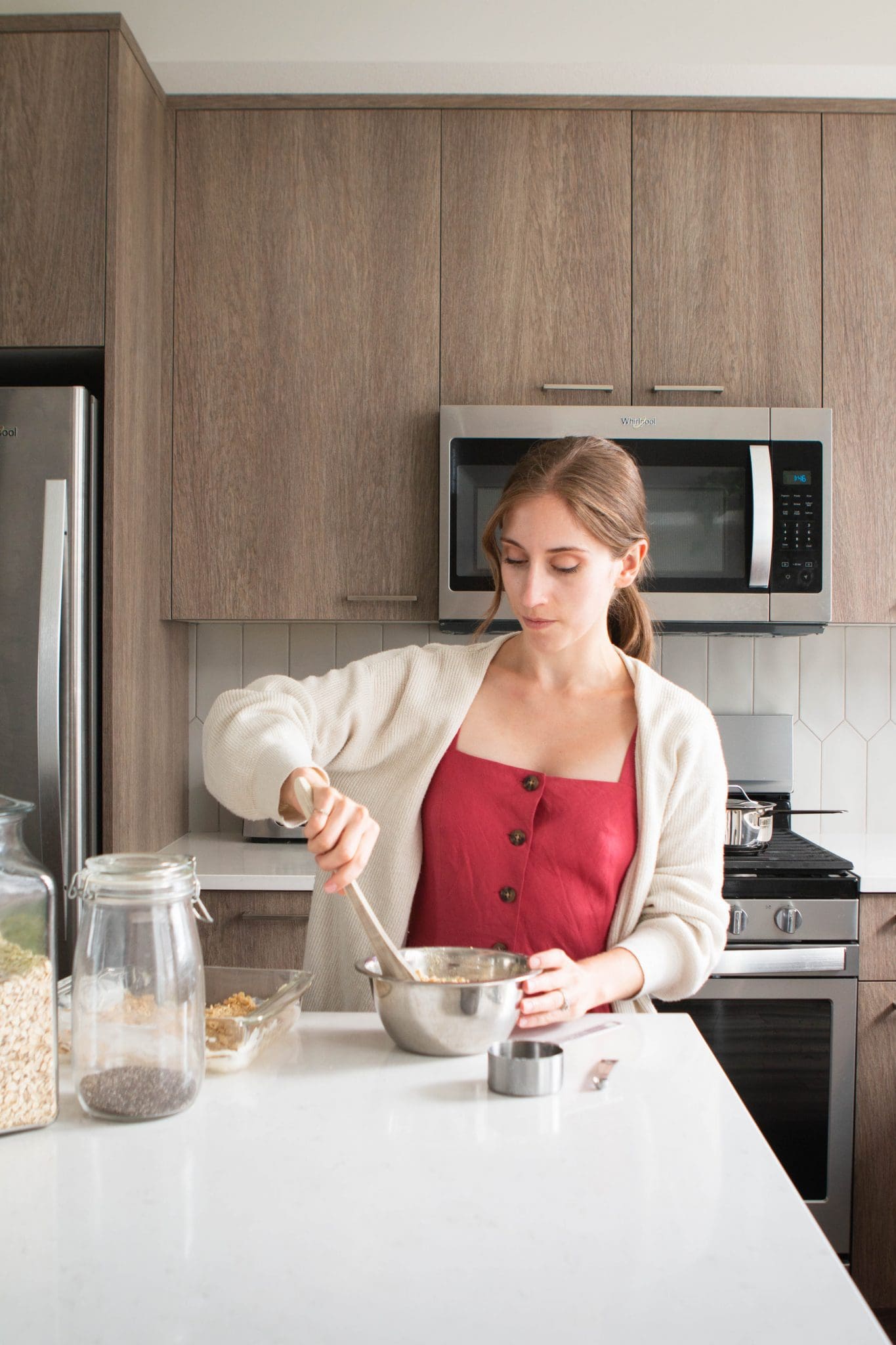How to prepare balanced vegan meals. Here you’ll learn how to build a balanced and satisfying vegan meal to make sure you’re getting the nutrients that you need!

Are you new to a vegan diet or are you looking to optimize your diet to get all the nutrients that you need? Here you’ll find some tips for planning and preparing balanced vegan meals!
Variety is important in any diet pattern, including a vegan diet. It’s the key to getting all the nutrients that you need in a day. But getting the essential nutrients and preparing balanced vegan meals doesn’t have to be complicated.
Let’s get started…
The Healthy Eating Plate
Let’s go back to the basics. A tool that dietitians often use to explain how to prepare balanced meals is the “healthy eating plate”. Canada’s Food Guide now uses this plate and it’s a simple way to picture a balanced meal. Here’s how it works…
Divide your plate into:
- 1/2 plate of vegetables
- 1/4 plate of grains and/or starches
- 1/4 plate of protein
Some include fruits with the vegetables and that’s how Canada’s Food Guide is illustrated. However, I would suggest adding fruit on the side and/or having it as a snack between meals. It’s your choice!
Also, while potatoes and sweet potatoes are technically vegetables, you can include them in the grains and starches section of your plate as they’re good sources of carbohydrates. Corn also falls in this category.
Keep in mind that this is a very simple and general guide to planning balanced meals. The truth is, most of your meals won’t look like this and that’s okay. Soups, casseroles, sandwiches and other “combination meals” can be perfectly balanced, without looking like the healthy plate.
Tips for Making Balanced Vegan Meals
You can use the healthy eating plate as a rough guide to balancing your meals, but here are other tips that can be helpful on a vegan diet:
Quick Tips:
- Fill half of your plate as vegetables
- Add a source of protein
- Add a source of carbohydrate
- Finish with a small amount of fat
- Don’t forget to add flavor
- Take your supplements
Let’s look at this in more details…
Fill Half of Your Plate with Vegetables
Don’t try to aim for perfection. However, regularly filling half of your plate with vegetables will help you get the vitamins, minerals (and fiber!) that you need. Vegetables are an important part of any diet, including a vegan diet.
Try having a side salad or simply roast, steam or grill your favorite vegetables. Make it interesting! Add flavor by using spices, herbs, sauces or a small pinch of salt. Find tips to eat more vegetables here.
What About Breakfast?
You don’t need to force yourself to eat vegetables in the mornings if it doesn’t feel natural to you. You can have a balanced breakfast without vegetables! A few tips: Try having a piece of fruit instead. You can add berries to your oatmeal or have a banana or an orange with your toasts for example. And of course, an easy way to sneak in vegetables in the mornings is to have a green smoothie.
Add Protein
Protein helps us feel satisfied and full after our meals. If you find yourself being hungry soon after eating, you might want to try adding more protein to your meals!
Can you get enough protein on a vegan diet? YES! Most people can easily meet their needs with a varied vegan diet. It’s simply a matter of learning what are the best vegan sources of protein, how to use them and being mindful of eating some of those foods daily.
Good sources of vegan protein:
- Lentils
- Beans
- Dried Peas
- Soy Products
- Nuts and nut butters
- Seeds and seed butters
Learn more about vegan protein here. And find tips for adding protein to your smoothies here.
Add Carbohydrates
You don’t need to be afraid of carbs! Carbs are an important part of any diet, including plant-based diets. They provide us with energy and help us feel satisfied and energized.
Try choosing whole grains or high-fiber carbohydrates most of the time. Fiber will promote satiety AND help with your digestive health.
Good sources of carbohydrates:
- Rice (brown, basmati, parboiled, etc.)
- Potatoes and sweet potatoes
- Oats
- Wheat (pasta, bread, etc.)
- Fruits
Try making a filling salad or bowl with roasted potatoes, quinoa or rice. You can also serve whole grain bread or crackers with soup. You could also finish your meal with fruit for a little something sweet.
Add Fats
Similarly to protein, fats will promote satiety. Fats are also important to help us absorb fat-soluble vitamins, so don’t skip the oil and salad dressing!
That being said, not all fats are the same nutrition-wise. It’s best to limit saturated and trans fats, while focusing on getting unsaturated fats.
Good sources of unsaturated fats:
- Avocados and avocado oil
- Nuts and nut butters
- Seeds and seed butters
- Olives and olive oil
Try cooking your vegetables with a drizzle of oil to promote satiety and help your body absorb fat-soluble vitamins. Other options could be to add avocado on top of your salad or casserole, spread nut or seed butter on your toasts or snack on nuts and seeds!
Most people get plenty of omega-6 (a type of unsaturated fat) in their diets, but many aren’t getting enough omega-3 fatty acids. For this reason, it’s not recommended to try and increase your omega-6 intake significantly or to take a supplement, but it is important to pay more attention to omega-3’s.
Omega-3’s: You can get plant-based omega-3 fatty acids in your diet from ground flax seeds, flax oil, chia seeds, walnuts and hemp hearts. Try getting 2-3 tablespoons of chia, flax or hemp seeds daily OR 1/4 cup of walnuts. Another option, which can be more convenient and reliable is to take an EPA/DHA algae supplement.
Don’t Forget to Add Flavor!
Nutrition is important, but so is the enjoyment that you get from eating. For that reason, make sure to prepare some delicious meals that you truly enjoy. This can be in the form of your favorite comfort foods, eating out occasionally or simply adding flavor to your favorite nutritious meals.
Tips for Adding Flavor:
- Add herbs and spices. Fresh herbs can also add a nice touch to many dishes.
- Add sauces, such as a dressing to your salad, a creamy tahini dressing to your vegetables, condiments to your sandwiches and veggie burgers and more.
- Use a small amount of salt. Yes, we shouldn’t overdo it on the salt (and listen to your doctor and/or dietitian if you’re on a salt restriction). But the truth is, we get most of our salt from packaged foods and restaurant meals. For that reason, if you make most of your meals at home and limit packaged foods, adding a small amount of salt is minimal comparatively.
- Cook with onions and garlic. These are the base of many recipes for good reasons. They’re packed with flavor (and nutrition)!
- Add nutritional yeast. It’s a great source of vitamin B12 (more on that later), but it also adds a delicious cheese-like flavor to your dishes. Try sprinkling it on salads, pasta or even popcorn!
- Use your favorite plant foods to add flavor and nutrition to your meals.
Take Your Supplements
While you can get most vitamins and minerals from a balanced vegan diet, there are times when supplements are necessary or helpful. On a vegan diet, the one supplement you should be taking is vitamin B12.
You can get vitamin B12 from fortified foods, such as nutritional yeast or plant-based milk, but a supplement can be easier and more reliable. Take at least 2500mcg once per week for maintenance OR 1000mcg 2-3 times per week OR 25-200mcg daily.
When it comes to supplements, it’s best to talk to a dietitian as individual needs may differ. You might also need higher doses if you’re deficient or haven’t been supplementing for a while. Learn more about supplements on a vegan diet here.
And that’s it! I hope you found these tips helpful. If you’re new to a vegan diet or if you’re concerned with your diet, I highly recommend talking to a registered dietitian with experience in plant-based diets. Everyone is different and individualized support can make a big difference.

New to a vegan diet? Make sure to read my 10 tips for new vegans! You can also learn more about getting enough iron on a vegan diet here.
Looking for dietitian support? Book a free 15-minute discovery call or an appointment with me here.
This information is intended for educational purposes only and is not meant to replace individualized nutrition or medical advice.













Leave a Reply